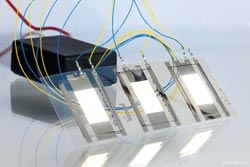Functional films for the displays of the future

Flexible OLED from Fraunhofer COMEDD encapsulated on both sides with high barrier films of Fraunhofer POLO.<br>
Displays that are flexible and paper thin at the same time?! What might still seem like science fiction will be a major topic at the SID Display Week 2013 that currently takes place in Vancouver in Canada.
High manufacturing cost and a short lifetime are still a major obstacle on the path towards commercial breakthrough of large-area and flexible OLED displays, roll-up e-paper and/or flexible luminous wallpaper. One reason for the high cost is the lack of cost-efficient and reliably large-area processes for flexible encapsulation of such devices.
But now, – at the SID Display Week – the Fraunhofer Institute for Electron Beam and Plasma Technology in Dresden presents a cost-effective roll-to-roll process to deposit ultra-high-barrier and display-adapted functional layers, which will make flexible components longer-living, more durable and cost-effective.
High-barrier films increase the lifespans of flexible electronic systems
The main reason why flexible electronics have a limited time of operation (lifetime) is because the active materials inside the devices are very sensitive against degradation from reaction with omnipresent moisture and oxygen. For instance, a flexible electronic system with the hypothetical size of a football field would not be able to tolerate more than a single drop of moisture ingress in one month. Normal polymer films, on the other hand, allow the diffusion of an entire tanker load of water vapour. Scientists at the Fraunhofer FEP are developing vacuum processes that will be able to productively enhance large polymer films with so-called high-barrier layers that eventually provide sufficient protection of flexible electronics against moisture.
In his presentation on 22 May 2013 (Session 29: Flexible Barriers and Substrate, 10:40 am), Dr. John Fahlteich, Senior Scientist at Fraunhofer FEP, will introduce a high-barrier coating with extremely low water vapour- and oxygen-permeability. With the help of a multi-layer system made from ORMOCER® hybrid-polymer and sputtered zinc-tin-oxide (ZTO) or aluminium oxide (Al2O3) layers water-vapour permeabilities of less than 8 x 10-5 g / (m2d) can be achieved at room temperature. The layer system, which was developed in cooperation with the Fraunhofer ISC in Würzburg (ORMOCER® development) and Fraunhofer IVV in Freising (ORMOCER® application), is currently one of the systems produced in a roll-to-roll process with the lowest water-vapor permeability properties in the world.
Low-cost roll-to-roll processes on a pilot scale
Dr. Fahlteich adds: „Low water-vapour permeation is one thing. But what is also special is the fact that we have been able to use roll-to-roll processes to apply the layers in a highly productive and favourable manner. Films of 400 millimetres width and up to 500 metres in length with reproducibly low water vapor permeation rates have already been coated on a pilot scale. The process is ready for up-scaling to industrial production.“ In addition to the applications for large, flexible displays, flexible lighting and flexible e-paper, the barrier layers may also be employed on organic transistors and organic solar cells.
Dr. Fahlteich’s presentation will finally demonstrate the application-specific enhancements of the technology by integration of multiple functionalities such as adaptation of the product‘s optical properties or addition of transparent electrodes to the high-barrier film.
Press contact: Annett Arnold
Fraunhofer-Institut für Elektronenstrahl- und Plasmatechnik FEP | Phone +49 351 2586 452 | Annett.Arnold@fep.fraunhofer.de
Winterbergstraße 28 | 01277 Dresden | Gemany |
Media Contact
All latest news from the category: Trade Fair News
Newest articles

Superradiant atoms could push the boundaries of how precisely time can be measured
Superradiant atoms can help us measure time more precisely than ever. In a new study, researchers from the University of Copenhagen present a new method for measuring the time interval,…

Ion thermoelectric conversion devices for near room temperature
The electrode sheet of the thermoelectric device consists of ionic hydrogel, which is sandwiched between the electrodes to form, and the Prussian blue on the electrode undergoes a redox reaction…

Zap Energy achieves 37-million-degree temperatures in a compact device
New publication reports record electron temperatures for a small-scale, sheared-flow-stabilized Z-pinch fusion device. In the nine decades since humans first produced fusion reactions, only a few fusion technologies have demonstrated…





















